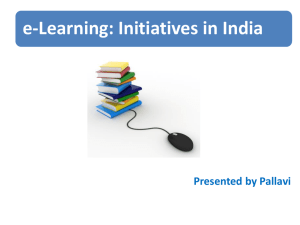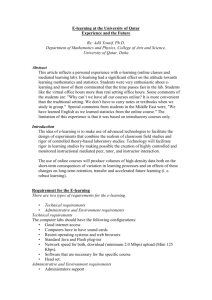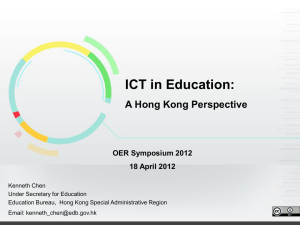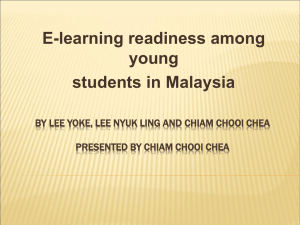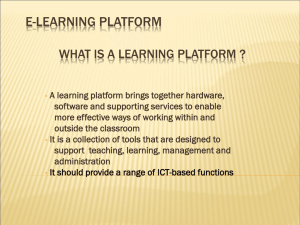The Future of e
advertisement
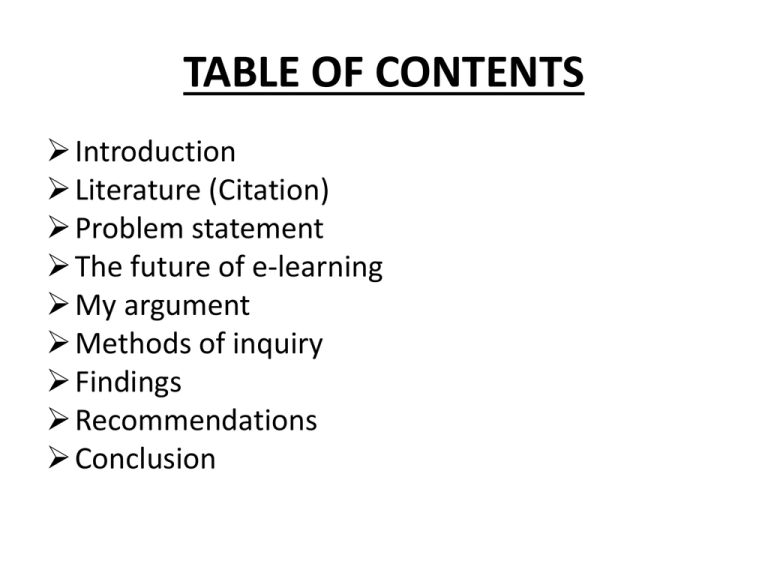
TABLE OF CONTENTS Introduction Literature (Citation) Problem statement The future of e-learning My argument Methods of inquiry Findings Recommendations Conclusion INTRODUCTION • The future is dark, the future is the thing we fear most the future is our despair but talking of the future of electronic learning so many people have different views based on how they apply elearning in their day to day lives, some say that the future of e-learning is social learning some say it is see it is bright and it is growth. In the scope of globalization one has to ask whether there can be a global culture without global information, and can global information exist in the world without global education? CITATION • David Nagel posits that “electronic learning is experiencing growth unprecedented growth and will continue to do that for the foreseeable future.” • According to research done by a firm Ambient Insight, electronic learning by dollar volume reached $27.1 billion in 2009 and predicting this figure will double by 2014. PROBLEM STATEMENT • The main problem being that as electronic learning is being applied in most education centers there are so many speculations concerning the future of e-learning based on conjecture rather than knowledge. Hence there is a need to give a detailed forecast so that the educators and the learners know where they stand in as far as electronic learning is concerned. I under took this study because it helps to make people understand the real facts behind the beginning of electronic learning, the impact it has on our education system and how it is likely to be in future. THE FUTURE OF E-LEARNING Contrary to popular credence, e-learning is not a new phenomenon. One can trace its beginning to the 1980s. Today e-learning is gaining more and more significance within the realm of higher and tertiary education. Electronic learning comprises of all forms of electronically supported learning and teaching. The information and communication systems serve as specific media to implement the learning process .considering the fact that since the 1980 up to date electronic learning has been expanding this means that its future is growth. According to the data analysis done below the future of e-learning is indeed growth.. BAR GRAPH SHOWING THE GROWTHE OF E-LEARNING SINCE 1980 100% 90% 80% 70% 60% traditional learning 50% E-learning 40% 30% 20% 10% 0% 1980s 1990 2000 2011 2014 A LINE GRAPH SHOWING HOW E-LEARNING HAS GROWN 5 4.5 4 3.5 3 2.5 2 1.5 1 0.5 0 1980 1990 2000 2011 MY ARGUMENT • My argument is that the future of electronic learning is bright and it is growth. And the same way letter writing has been replaced by electronic mailing is the same way the board, the chalk and the duster are going to be replaced by electronic learning. METHODOLOGY • I have done a critical study researching and got information from the following internet search ,documentary analysis and interviews. • From the internet I got information on how the world at large is applying e-learning and how it is most likely to be in future based on how it has grown. • Documentary analysis was also done and graphs and charts were collected. • Interviews were done in Mthatha and surrounding areas FINDINGS • I grouped the findings I got from my research into two groups 1. Those who say the future of e-learning is bright.(73%) 2. Those who say it is doomed and it destroys the education system.(27%) • Be that as it may, from what I have gathered it seems that e-learning has already carved itself a spot in the world and I really do not see any opportunity to get rid of it. RECOMMENDATIONS • As you well know, technology can be a powerful tool for learning, and it can be the same for cheating. It can be used to inform, and to distort. It can boldly open new doors, while flinging open some that were perhaps best left closed; not every topic is appropriate for all age groups. • The complaint should be formed into a question: is there a way to employ new technology intelligently avoiding its pitfalls while reaping its rewards? • Yes, due to the above explained problems associated with electronic learning I recommend that we should strive to have strong teachers, by having strong and smart teachers who can use the tools that technology offers without falling on their sharp ends, we can seal all the loopholes that elearning has. CONCLUSION • Finally, and to wrap up, technology is changing our world, and we have to understand the implications of its use for our children’s education. Education is affected by technology in a very real way; however the timeless goals of education should be respected. Information about e-learning is now moving upward from boring graphs into the world of more exciting visuals. In a nut shell electronic Learning offers practical and cost effective ways for , higher education institutions as well as academic institutes to manage the delivery of education over the web and manage administrative aspects of education at the same time. Its future is indeed growth and expansion.




